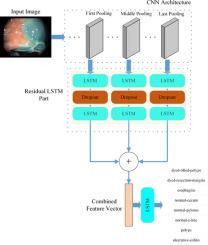Journal of Biomedical informatics ( IF 4.0 ) Pub Date : 2020-12-01 , DOI: 10.1016/j.jbi.2020.103638 Şaban Öztürk 1 , Umut Özkaya 2

|
Nowadays, considering the number of patients per specialist doctor, the size of the need for automatic medical image analysis methods can be understood. These systems, which are very advantageous compared to manual systems both in terms of cost and time, benefit from artificial intelligence (AI). AI mechanisms that mimic the decision-making process of a specialist increase their diagnosis performance day by day, depending on technological developments. In this study, an AI method is proposed to effectively classify Gastrointestinal (GI) Tract Image datasets containing a small number of labeled data. The proposed AI method uses the convolutional neural network (CNN) architecture, which is accepted as the most successful automatic classification method of today, as a backbone. According to our approach, a shallowly trained CNN architecture needs to be supported by a strong classifier to classify unbalanced datasets robustly. For this purpose, the features in each pooling layer in the CNN architecture are transmitted to an LSTM layer. A classification is made by combining all LSTM layers. All experiments are carried out using AlexNet, GoogLeNet, and ResNet to evaluate the contribution of the proposed residual LSTM structure fairly. Besides, three different experiments are carried out with 2000, 4000, and 6000 samples to determine the effect of sample number change on the proposed method. The performance of the proposed method is higher than other state-of-the-art methods.
中文翻译:

残留LSTM分层CNN用于胃肠道疾病分类
如今,考虑到每位专科医生的患者人数,可以理解自动医学图像分析方法的需求量。与人工系统相比,这些系统在成本和时间上都非常有优势,它们将从人工智能(AI)中受益。模仿专家决策过程的AI机制取决于技术的发展,其诊断性能每天都在提高。在这项研究中,提出了一种AI方法来有效地分类包含少量标记数据的胃肠道图像数据集。所提出的AI方法使用卷积神经网络(CNN)架构作为骨干,该架构被公认为当今最成功的自动分类方法。根据我们的方法,浅层训练的CNN架构需要强大的分类器支持,才能对不平衡的数据集进行可靠的分类。为此,将CNN体系结构中每个池化层中的功能传输到LSTM层。通过合并所有LSTM层进行分类。所有实验均使用AlexNet,GoogLeNet和ResNet进行,以公平地评估提议的残留LSTM结构的贡献。此外,对2000、4000和6000个样本进行了三个不同的实验,以确定样本数量变化对所提出方法的影响。所提出的方法的性能高于其他最新技术。CNN体系结构中每个池化层中的功能都传输到LSTM层。通过合并所有LSTM层进行分类。所有实验均使用AlexNet,GoogLeNet和ResNet进行,以公平地评估提议的残留LSTM结构的贡献。此外,对2000、4000和6000个样本进行了三个不同的实验,以确定样本数量变化对所提出方法的影响。所提出的方法的性能高于其他最新技术。CNN体系结构中每个池化层中的功能都传输到LSTM层。通过合并所有LSTM层进行分类。所有实验均使用AlexNet,GoogLeNet和ResNet进行,以公平地评估提议的残留LSTM结构的贡献。此外,对2000、4000和6000个样本进行了三个不同的实验,以确定样本数量变化对所提出方法的影响。所提出的方法的性能高于其他最新技术。和6000个样本,以确定样本数量变化对所提出方法的影响。所提出的方法的性能高于其他最新技术。和6000个样本,以确定样本数量变化对所提出方法的影响。所提出的方法的性能高于其他最新技术。











































 京公网安备 11010802027423号
京公网安备 11010802027423号